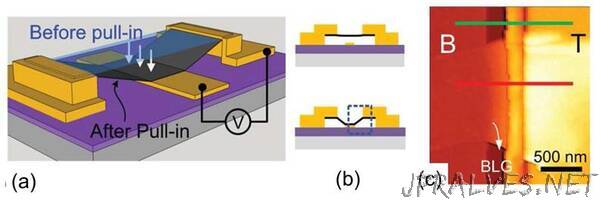
“A research group at School of Materials Science / Energy and Environment division at Japan Advanced Institute of Science and Technology (JAIST, President Testuo Asano), succeeded to detect a single CO2 molecule electronically by using a newly developed nano-scale sensor device with a suspended graphene, which will have major implications for future environmental sensing and monitoring technologies.
In recent years, health problems due to air pollution in the personal living space are getting serious as represented by sick building syndrome (SBS). Very dilute chemical gas molecules such as volatile organic compounds (VOC) originated from building and interior materials, furniture and even from daily commodities adversely affect us living in modern houses with good insulation. Sick car and sick school syndromes have also become issues recently. Over one million patients presumably suffer from those syndromes in Japan. However, those harmful chemical gases are very dilute with concentration of low ppb (parts per billion) level and it is extremely difficult to detect with the current gas sensor technology.
A research group of Prof. Hiroshi Mizuta, Dr. Jian Sun and Assistant Prof. Manoharan Muruganathan at JAIST successfully developed a novel principle to detect individual CO2 molecules adsorbed onto the suspended graphene (single atomic sheet of carbon atoms arranged in a honeycomb-like hexagonal crystal lattice structure) one by one electronically. Even under a very dilute gas environment equivalent to the ppb level, high-speed molecule detection is achieved by accelerating the gas molecules adsorption onto graphene by applying an electric field.
By using NEMS (nano-electro-mechanical systems) fabrication technology, a doubly-clamped suspended bilayer graphene beam was built on a semiconductor substrate. By applying an electric field from the substrate, few CO2 gas molecules were drawn and adsorbed onto the graphene beam. By monitoring the electrical resistance of the graphene beam, the adsorption and desorption processes of individual CO2 molecules onto the graphene were detected as ‘quantized’ changes in resistance (step-wise increase or decrease in resistance). In the present demonstration, a very small volume of CO2 gas introduced in this demonstration is equivalent to the concentration of approximately 30 ppb, and the detection time was only few minutes.
In contrast to the commercially available environmental monitoring tools, this extreme sensing technology enables to realize significant miniaturization, weight and cost reduction in addition to a remarkable improvement in the detection limit from the ppm levels to ppb levels.
The technical details of the present work was reported on 15th April in the online edition of “Science Advances” journal of the American Association for the Advancement of Science (AAAS). In addition, the physical mechanism of single-molecule detection was published online on 12th November, 2015 in the “Nano Letters” journal of American Chemical Society (ACS).
The research Project details:
Research Funding: Japan Grant-in-Aid for Scientific Research (KAKENHI) (S)
Title of Project: Development of graphene NEMS hybrid functional devices for autonomous and ultrasensitive integrated sensors
Principal Investigator: Hiroshi Mizuta (Japan Advanced Institute of Science and Technology, Professor)
Term of Project: FY2013-2017
JSPS KAKENHI Grant Number: 25220904”
